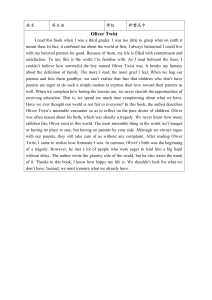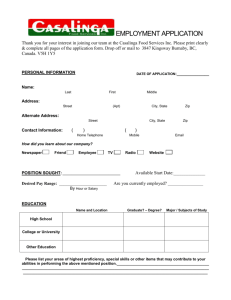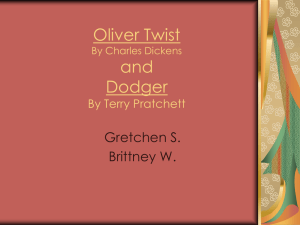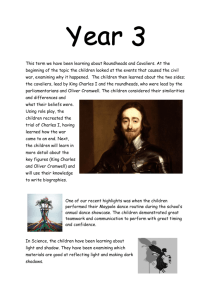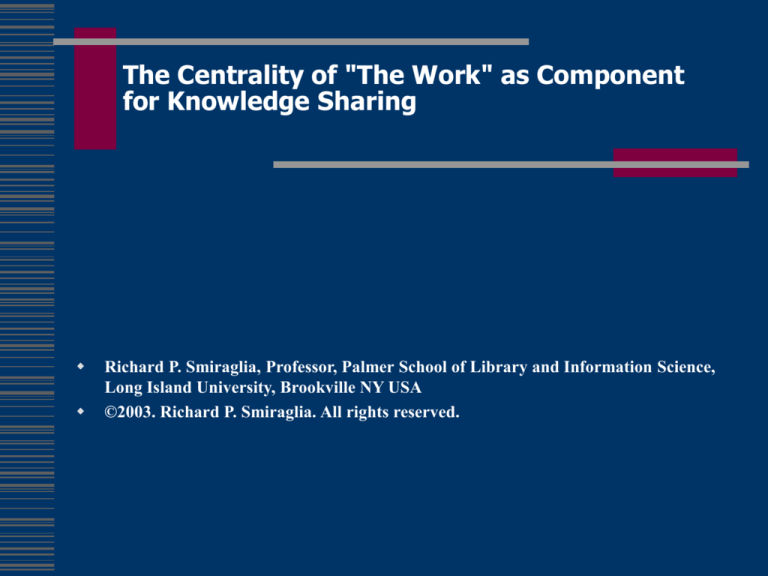
The Centrality of "The Work" as Component
for Knowledge Sharing
Richard P. Smiraglia, Professor, Palmer School of Library and Information Science,
Long Island University, Brookville NY USA
©2003. Richard P. Smiraglia. All rights reserved.
Contexts - Sources
Knowledge organization, bibliographic control
Documentation, information retrieval
Extending the model to information objects generically
speaking
A work is essentially one potential property of an informing
object
The Nature of ‘A Work’: Implications for the Organization of Knowledge. (Lanham, Md.:
Scarecrw, 2001)
Works as Entities for Information Retrieval. (Binghamtom, NY: Haworth Information Press,
2002)
“Works as signs, symbols, and canons: The epistemology of the work.” Knowledge organization
28 (2002): 192-202.
Framing the Discussion
Text, Document, Work – Document, Documentary Entity, Document
Content
Signs and Symbols
Treatment of Works in Retrieval
The Evidence: Derivative Relationships
Toward a Theory of the Work
Toward a Meta-theory of Document Content
The Documentary Entity
Document: A unique
instance of recorded
knowledge.
Content always conveyed
by “text.”
Deliberate text may
constitute a “work.”
Regardless, the intellectual
content is distinct from the
physical instantiation
Documentary Entity
Document
(physical)
Work
(intellectual)
text
Text, Document, and Work
A text is the set of words that constitute a writing.
A document is the physical container (an "item") on which a text is recorded.
A work is the set of ideas created, set into a document using text, with the
intention of being communicated to a receiver.
A work is represented by semantic and ideational content.
A given physical instantiation is essentially a realization at a specific point in
time of the semantic and ideational content.
Instantiation Taxonomy (earlier: Derivative Bibliographic Relationships)
Simultaneous derivations
Successive derivations
Translations
Amplifications
Extractions
Adaptations
Performances
An Operational Definition Of A Work
Work is the intellectual content of a bibliographic entity; any work has two
properties: a) the propositions expressed, which form ideational content; and b)
the expression of those propositions (usually a particular set of linguistic (musical,
etc.) strings), which form semantic content.
Characteristics of Works
"Work" is an abstract concept (immaterial, conceptual)
A work is a new synthesis of knowledge that consists of ideational
content and semantic content
Once expressed a work may take a variety of physical instantiations
The expression of a work may change freely in either ideational or
semantic content or both
Relationships among works are complex
A work's essential role is as a vehicle of communication between its
creator and its consumers
Volatility Is an Essential Trait of Works
Change in the expression of the semantic and ideational content
Variation in the perception of semantic and ideational content
Evolution in ownership
Saussure’s System of Sign, Signfied, Signifier
A sign "unites a concept and a sound image" (1959, 66).
The signified is the concept under conveyance
The signifier is the sound-image used to convey the concept (1959, 67).
Signifiers are fixed in the linguistic communities that use them, and therefore
have the property of immutability (1959, 71).
But over time signifiers (and ultimately signs) change--mutate--and therefore
linguistic signs are mutable.
Saussure, Ferdinand de. 1959 (repr. 1966) Course in General Linguistics. Ed. by Charles
Bally and Albert Sechehaye; in collaboration with Albert Riedlinger; trans., with an introd.
and notes by Wade Baskin. New York: McGraw-Hill.
Peirce’s Triad of Types of Signs
Firstly, there are likenesses, or icons; which serve to convey ideas of the
things they represent simply by imitating them
Secondly, there are indications, or indices; which show something about
things, on account of their being physically connected with them
Thirdly, there are symbols, or general signs, which have become
associated with their meanings by usage. Such are most words, and
phrases, and speeches, and books, and libraries.
Peirce, Charles Sanders. 1998. The essential Peirce: Selected Philosophical Writings. Vol. 2
(1893-1913), ed. by the Peirce Edition Project, Nathan Houser [et al.], p. 4-10, "What is a Sign?"
Bloomington: Indiana Univ. Pr.
Peirce’s Symbol
Representamen
Object
Interpretant
Interpretant
Representamen
Representation of dynamic conceptual instantiation
Object
Poster's Concept of "Mode of Information"
Cultural history is demarcated by variations in the structure of symbolic exchange
(1990, 5). Every society makes elemental use of symbolic exchange ... Works are
required to facilitate the preservation and propagation of the culture through
formal symbolic exchange (1990, 7).
Poster, Mark. 1990. The Mode of Information: Poststructuralism and Social Context. Univ.
of Chicago Pr.
Eggert's Concept of the Work As a Collaborative Entity
Changed over time by those who embrace it--the more embraced the more
changed--that is, the more popular the works the more likely we will observe
derivation over time.
Eggert, Paul. 1994. "Editing Paintings/Conserving Literature: The Nature of the
'Work.'" In Studies in Bibliography v.47 ed. by David L. Vander Meulen, pp. 65-78.
Charlottesville, Pub. for The Bibliographical Society of the University of Virginia by
The University Press of Virginia.
A Work is A Cultural Artifact
A new work clearly is unique at the point of its creation
Its ownership is clear for that single moment when the work is fixed for the first
time in tangible form.
At this point the work has the quality of the linguistic signifier--immutable and
clearly definable both in its ideational and semantic content and in its social role
for the culture in which it is created.
Once the work is released to the public it becomes inherently mutable in a
variety of ways.
Works are volatile; changeable in the expression of their content, variable in
their perception among those who receive them, and constantly evolving in
ownership as they progress through their collaborative social roles.
Works change over time, they take on new meanings as they are assimilated in
cultures, they reflect their perceptions, and they evolve in content and tangibility.
Works are Analogous to Signs
Works can be seen as analogous to
signs that are inescapably mutable
over time. The texts of works are
signifiers that are clearly immutable
when first fixed, but which have
other properties that are mutable.
Gérard Genette (1997) posited a
theory of "paratexts"--essentially
preliminaries--which themselves
mutate over time as a function of the
reception history of the particular
work to which they attend.
Empirical Evidence from the
Bibliographic Universe
The size of a bibliographic family seems to be related to its popularity, or ... its
canonicity. Most bibliographic families are formed and reach full size soon after
publication of the progenitor. On the other hand, older progenitors are the locus
for larger bibliographic families.--Smiraglia and Leazer (1999)
Proportion of Works Demonstrating Derivative Bibliographic
Relationships
Site
Proportion
49.9%
Confidence
interval
±4%
Confidence
level
.095
Georgetown
WorldCat
Burke
Theology
Bobst
Theology
30.2%
52.9%
±4%
±10%
.095
.090
57.9%
±6%
.095
Bestsellers
98%
±2%
.095
Age of the Progenitor
Site
Constant
Georgetown
Regression
Coefficient
.123
WorldCat
.002
.239
Burke Theology
.01
2.2
Bobst Theology
.006
2.3
Bestsellers
.002
.039
.84
Extent of Instantiation Networks
Mean
Georgetown
8.4
WorldCat
3.5
Bobst Theology
4.2
Burke Theology
5.8
Bestsellers
28.17
Distribution of Derivation
*categories of musical derivation only
Smiraglia (1992)
Georgetown
Smiraglia and
Leazer (1999)
OCLC Worldcat
Smiraglia (2000)
NYU
Smiraglia (2000)
UTS
Simultaneous
23.4%
7.1%
34%
18%
Successive
82.4%
55.5%
76%
80%
Predecessor
13.1%
14.2%
4%
4%
Translation
30.2%
6.8%
26%
26%
12.2%
Amplification
7.3%
2.2%
6%
2%
47.1%
Extraction
2.4%
1.6%
4%
2%
Performance
4.3%
1.6%
Adaptation
2.7%
.9%
2%
Vellucci (1994)
Sibley
51.7%
56.8%
35.9%
Arrangement*
35.6%
Musical
presentation*
33.7%
Notational
transcription*
2.4%
Studhorse Man by Robert Kroetsch
New York
1969
paper
New
York
1970
New
York
1971
New
York
1969
(boards)
Toronto
1969
Ontario
1973
Ontario
1977
Ontario
1982
Ontario
1988
London
1969
L'eleveur
d'étalon
Sherbourne
French Trans.
1985
L'étalon
Montreal
French Trans.
1990
A Thousand Miles up the Nile by Amelia B. Edwards
1877
Edinburgh
1891
London
1877
London
1891
New York
1877
New York
[1891]
New York
1888
Boston
1897a
Boston
1888
Chicago
1897b
Boston
1888
London
1899
London
1888
New York
1900
Philadelphia
1888
Philadelphia
1978
Leipzig
1889
London
1982
London
1889
New York
1983
Boston
1890
London
1989
Boston
1890a
New York
1991
Connecticut
1890b
New York
1993
London
[1891]
Boston
1891
Boston
“Works” Language
FRBR – Work, Expression, Manifestation, Item
Carlyle, Svenonius, Yee – Works and Superworks
Leazer and Furner – Textual Identity Networks
Smiraglia – Instantiation, Derivation, Mutation
Toward a Theory of The Work
A work is the intellectual content of a bibliographic entity.
A work functions in society in the same manner that a sign functions in
language.
A work has the characteristics of a Peircean symbol—general signs
associated with their meanings by usage over time.
A work is potentially a collaborative phenomenon over time.
Works that are assumed into the canon of their cultures are likely to
generate families of derivations.
Certain bibliographic characteristics of literatures--predominantly age of
the progenitor--can be used to predict which works in the bibliographical
universe at large have entered the canon, by virtue of the extent of their
bibliographical families.
Epistemological Ramifications: 1
Hjørland (1998) asserts a basic epistemological approach to fundamental
problems of information retrieval, particularly to the analysis of the
contents of documentary entities … Hjørland lists four basic
epistemological stances:
Empiricism: derived from observation and experience;
Rationalism: derived from the employment of reason;
Historicism: derived from cultural hermeneutics; and,
Pragmatism: derived from the consideration of goals and their
consequences.
Epistemological Ramifications 2
The nominal anchor for a work (its citation) is a historical construct.
Empiricism demonstrates the multiplicity of instantiations, and the
characteristics of arbitrariness and linearity in their evolution over time.
Rationalism allows us to perceive the cultural roles of works as communicative
vehicles (I.e., not only informative documents).
Pragmatism leads to the development of normative constructs for retrieval of
works—cf. IFLA’s FRBR model.
Semiotic Representation of IFLA’s FRBR Model
Interpretant2
Item
FRBR
Work
Expression
Manifestation
Item
Interpretant1/Representamen2
Expression
Representamen1
conception
Object2
Manifestation
Object1
Work
Charles Dickens
Oliver Twist
1139 English
instantiations in OCLC
Continued reception from
1838 to present
Total adaptation not
distinguished (viz. Lionel
Bart’s musical)
Dickens, Charles,
Dickens, Charles,
Dickens, Charles,
...
Dickens, Charles,
Dickens, Charles,
Dickens, Charles,
...
Dickens, Charles,
Dickens, Charles,
Dickens, Charles,
Dickens, Charles,
...
Dickens, Charles,
Dickens, Charles,
...
Dickens, Charles,
Dickens, Charles,
Dickens, Charles,
Dickens, Charles,
...
Dickens, Charles,
Dickens, Charles,
Dickens, Charles,
Dickens, Charles,
Dickens, Charles,
...
Dickens, Charles,
Dickens, Charles,
Dickens, Charles,
Dickens, Charles,
Dickens, Charles,
...
Dickens, Charles,
Oliver Twist; or, The parish J. Duncombe & 1838
Oliver Twist; or, The parish J. Turney, Jr. 1838
Oliver Twist, or the parish b
1838
Oliver Twist
Oliver Twist /
Oliver Twist /
Chapman and Ha 1850
Getz, Buck, 1853
T.B. Peterson, 1854
Oliver Twist.
Oliver Twist
Oliver Twist /
Oliver Twist.
Hearst's Inter 1868
The Mershon Co 1868
Hurd and Hough 1869
Chapman & Hall 1870
Oliver Twist a serio-comic bu Samuel French, 1864
Oliver Twist : a serio-comic John Dicks, 1879
Oliver Twist /
Oliver Twist /
Oliver Twist /
Oliver Twist /
Oxford Univers 2000 U
Longman,
2000 U
Dorling Kinder 2000 D
Modern Library 2001 D
Oliver!
Columbia Pictu 1968
Oliver!
RCA/Columbia P 1985
Oliver!
Columbia Trist 1987
Oliver and the artful Dodger Worldvision Ho 1985
Oliver and the artful Dodger Hanna-Barbera 1989
Oliver Twist
Oliver Twist.
Oliver Twist
Oliver Twist
Oliver Twist
Oliver! /
Decca,
1960
Columbia,
1960
Golden Records 1962 D
Books on Tape, 1977
Listen For Ple 1977
Hollis Music, 196
Oliver Twist in the Catalog
Dickens, Charles, 1812-1870.
[Oliver Twist]
[Oliver Twist. Chinese]
[Oliver Twist. Dutch]
[Oliver Twist. French]
[Oliver Twist. German]
[Oliver Twist. Hebrew]
[Oliver Twist. Japanese]
[Oliver Twist. Spanish]
[Oliver Twist. Ukrainian]
...
Bart, Lionel.
[Oliver! Selections]
Works as Entities for Information Retrieval
Partial Concept Map
Works
Information retrieval entities
Record clustering
Bibliographic record as text and paratext
Networked electronic environment
Typologies
Cartographic works
Collected works as genus
Digitized works
Collected works as species
Composite multimedia
Performed works—Action as signification
Scientific works—Genres
Scientific models—Metadata representation
Theological works—Genres
Scripture and Revelation
Video works and non-works--Taxonomy
Knowledge organization
Ontology
Epistemology
Action vs. text
Text and paratext
Taxonomy
Representation
Entity-relationship
Semiotics
Semiotic of Scientific Meaning
Levels of signification—Phenomenology,
Description, Explanation
From Document to Object
Instantiation understood as content geneology
As yet undescribed categories of mutation and derivation
Re-presentation of object (fine art, natural science) clearly
precedes instantiation
The epistemology of the documentary work can be extended
as a pragmatic tool for the development of metadata and
other documentation practices for knowledge-sharing about
works across domains.
Just as some documents contain non-works, so do many real
world information objects
Non-works have distinct ideational and expressive content
apart from their carriers
An Architecture of Content Geneology
Interpretant2
Nominal Anchor
(the Name of the
Work)
-Instantiation of the
Original
-Re-presentation of the
Instantiation
-Mutation, Derivation,
Etc. of the Representation
Representamen1
Interpretant1/Representamen2
Object2
Object1
Outline of a meta-theory
Theory of “works”
Theory of the interaction of signification and reception
The evolution, derivation, and mutation of ideational and expressive
content across:
Time
Culture
Linguistic boundaries
Canonicity
Etc.
Lacunae: empirical evidence of the geneology of re-presentation

